Breaking News
Milkor strengthens its position with a full-spectrum defense portfolio at AAD 2024.
At the Africa Aerospace and Defence (AAD) 2024 exhibition, the South African company Milkor displayed a wide array of products across multiple domains. These included the Milkor 380, noted as the largest medium-altitude long-endurance (MALE) UAV produced in Africa, as well as armored vehicles like the Milkor Vanguard APC, the Milkor BushCat in a SWAT variant, and the Milkor Frontier, available in both 4x4 and 6x6 configurations. Additionally, the company presented the Milkor Commander patrol craft and the Milkor Inshore Patrol Craft (IPC) catamaran, along with the Milkor AGL 40mm automatic grenade launcher.
Follow Army Recognition on Google News at this link

Designed for Intelligence, Surveillance, and Reconnaissance (ISR) missions as well as precision strikes, the Milkor 380 offers optical systems for high-definition, infrared, and multispectral imaging to support real-time situational awareness. (Picture source: Army Recognition)
The Milkor 380, currently the largest medium-altitude long-endurance (MALE) UAV produced in Africa, is projected to be among the world's top ten in its category. It has a maximum range exceeding 4,000 kilometers, operates continuously for up to 30 hours, and surpasses several renowned UAVs in operational endurance. Designed for Intelligence, Surveillance, and Reconnaissance (ISR) missions as well as precision strikes, the Milkor 380 offers optical systems for high-definition, infrared, and multispectral imaging to support real-time situational awareness.
The UAV's design includes five hardpoints to accommodate a variety of payloads, such as sensor pods, glide bombs, and electronic warfare systems, making it adaptable for multiple mission requirements. It features technologies like Synthetic Aperture Radar (SAR) and Inverse Synthetic Aperture Radar (ISAR) for maritime surveillance and extended operations. The Milkor 380 is capable of autonomous flight operations, including take-off, flight, and landing, with minimal human involvement, facilitated by its built-in flight control system. Communication is supported through dual redundant Line of Sight (LOS) and satellite systems, and it integrates with existing Command, Control, Communications, Computers, Intelligence, Surveillance, and Reconnaissance (C4ISR) systems.
Milkor has expanded its production capacity at its Cape Town facility, allowing annual output to increase from 8 to 16 units by 2026, reflecting the growing interest in the Milkor 380. The UAV's specifications include a service ceiling of 30,000 feet, speeds up to 250 km/h, and a payload capacity of up to 400 kg. These features, along with the integration of advanced communication systems and compatibility with various payloads, contribute to its role in a range of military applications, such as the Aeroforce 380 for maritime surveillance.

The Milkor Vanguard meets NATO STANAG 4A and 4B protection standards, allowing it to withstand a 10 kg anti-tank mine detonation under its wheels or the vehicle itself, which offers a level of protection comparable to the International MaxxPro, utilized by the Ukrainian Armed Forces. (Picture source: Army Recognition)
At the Africa Aerospace and Defence (AAD) 2024 exhibition, Milkor introduced the Vanguard Armoured Personnel Carrier (APC), a new Mine-Resistant Ambush Protected (MRAP) vehicle. Designed for various military applications, the Vanguard can be configured for infantry fighting, border patrol, medical support, and command operations. The vehicle meets NATO STANAG 4A and 4B protection standards, allowing it to withstand a 10 kg anti-tank mine detonation under its wheels or the vehicle itself, which offers a level of protection comparable to the International MaxxPro, utilized by the Ukrainian Armed Forces.
Equipped with STANAG Level 3 ballistic armor, the Vanguard is designed to protect against 7.62 x 51 mm armor-piercing rounds fired from 30 meters. It accommodates two crew members and eight passengers, providing flexibility in roles such as an infantry fighting vehicle, armored personnel carrier, or field ambulance. The Vanguard includes weapon systems like manned turrets, remote stations, and smoke launchers, along with electronic warfare capabilities such as jammers and signal intelligence (SIGINT) systems, features that distinguish it from other MRAPs, including Russian models like the Typhoon-K.
Powered by a 336 kW (450 hp) engine, the Vanguard has a top speed of 100 km/h and an operational range of 900 km. It is capable of navigating terrains with 60% gradients, 35% side slopes, and trenches up to 1 meter wide. The vehicle's power-to-weight ratio, approach and departure angles, and off-road capabilities provide adaptability for challenging missions, offering different operational aspects compared to similar vehicles like the Typhoon-K, which has a longer range of up to 1,200 km.
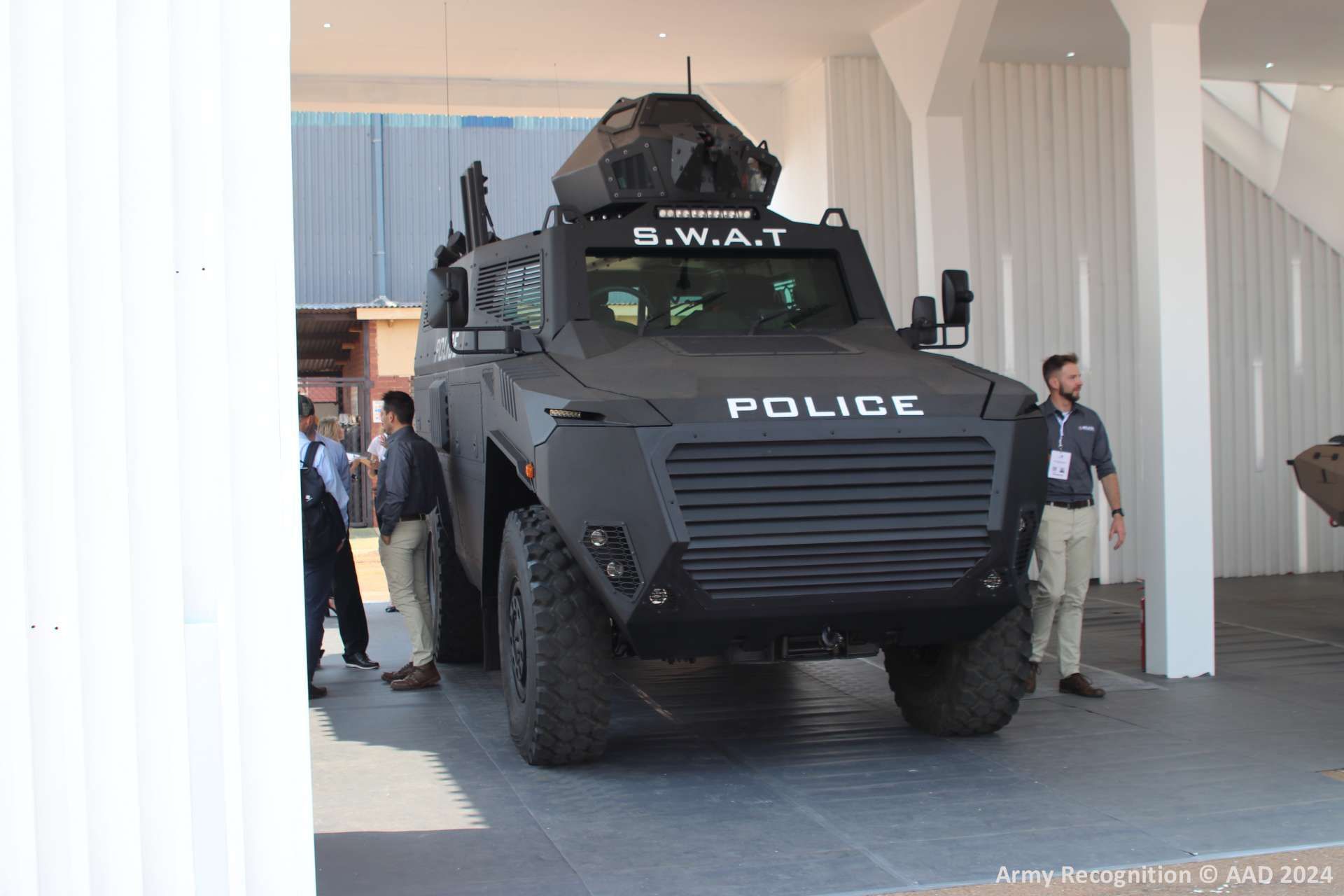
The Milkor BushCat is offered in variants such as an infantry fighting vehicle, armored personnel carrier, border patrol vehicle, military field ambulance, and command vehicle. (Picture source: Army Recognition)
Another vehicle on display was the Milkor BushCat, a 4x4 armored personnel carrier (APC) presented in a SWAT variant, which is developed from Milkor's earlier APC model, the Milkor 4x4. The BushCat incorporates lessons learned from previous customers, as it is based on an Iveco truck chassis, which facilitates maintenance and access to spare parts. The vehicle is designed to meet a range of operational needs, with configurations available for roles such as an APC, police riot control, police special operations, border surveillance, field ambulance, and command vehicle. The BushCat is primarily aimed at the African market as a cost-effective option for military and peacekeeping operations.
The BushCat adheres to the North Atlantic Treaty Organisation (NATO) STANAG standards for protection. It meets STANAG 3a and 3b levels for blast protection, capable of withstanding an 8 kg anti-tank mine explosion under any wheel or the vehicle's hull. For ballistic protection, it is rated at Level 2, meaning it can resist 7.62 x 39 mm armour-piercing incendiary ammunition fired from 30 meters away or shrapnel from a 155 mm artillery shell detonating 80 meters away. The vehicle's gross vehicle mass (GVM) is 13.5 tons, and it can carry a crew of two along with eight passengers. It can be equipped with manned or unmanned weapon stations or turrets.
The BushCat has a maximum speed of 110 km/h and a range of 1,000 km, designed to operate effectively in rugged terrain and harsh conditions. Its modular design allows customization, and it is offered in variants such as an infantry fighting vehicle, armoured personnel carrier, border patrol vehicle, military field ambulance, and command vehicle. The vehicle's features are intended to ensure adaptability for diverse mission profiles, including peacekeeping, border security, law enforcement, and military operations.
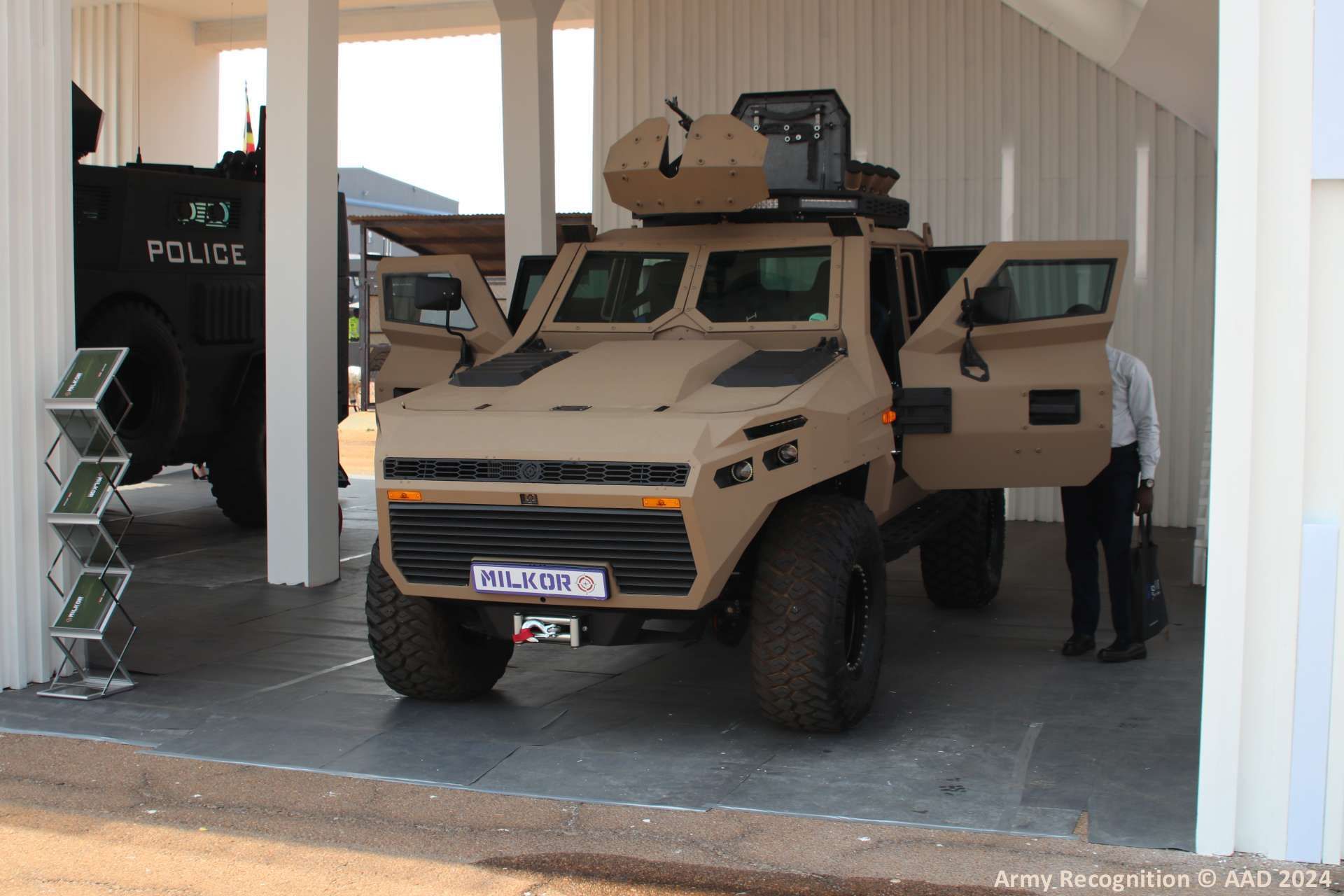
The Milkor Frontier, a tactical vehicle available in both 4x4 and 6x6 configurations, is designed for various roles such as security operations, patrols, special operations, and utility tasks. (Picture source: Army Recognition)
Next to the BushCat, Milkor displayed its new Milkor Frontier, a tactical vehicle available in both 4x4 and 6x6 configurations, designed for various roles such as security operations, patrols, special operations, and utility tasks. It is suitable for military, paramilitary, border surveillance, and civilian applications, including firefighting. The vehicle's modular design allows for the integration of different payloads, making it adaptable to a range of mission requirements. It is built for off-road mobility, allowing it to navigate diverse terrains.
The 6x6 version of the Milkor Frontier uses the Toyota Land Cruiser chassis, with a GVM (Gross Vehicle Mass) of 8,700 kg, a maximum speed of 120 km/h, and a range of 750 km. It can carry up to 12 people and offers configurations such as troop carrier, long-range patrol vehicle, rapid response vehicle, and vehicle-mounted weapon system. The 4x4 variant has a GVM of 5,700 kg, with the same speed and range, and is intended for tasks like border surveillance and rapid response, available in versions including utility, raiding, and surveillance.
Both versions offer ballistic protection up to B6 level, with optional STANAG Level 1 blast protection. The vehicles can be equipped with modular armor and weapon stations as needed, ensuring adaptability to mission-specific requirements. The Milkor Frontier, presented at AAD 2024, addresses the need for a flexible military transport solution, particularly in regions requiring mobility and cost-effective options.
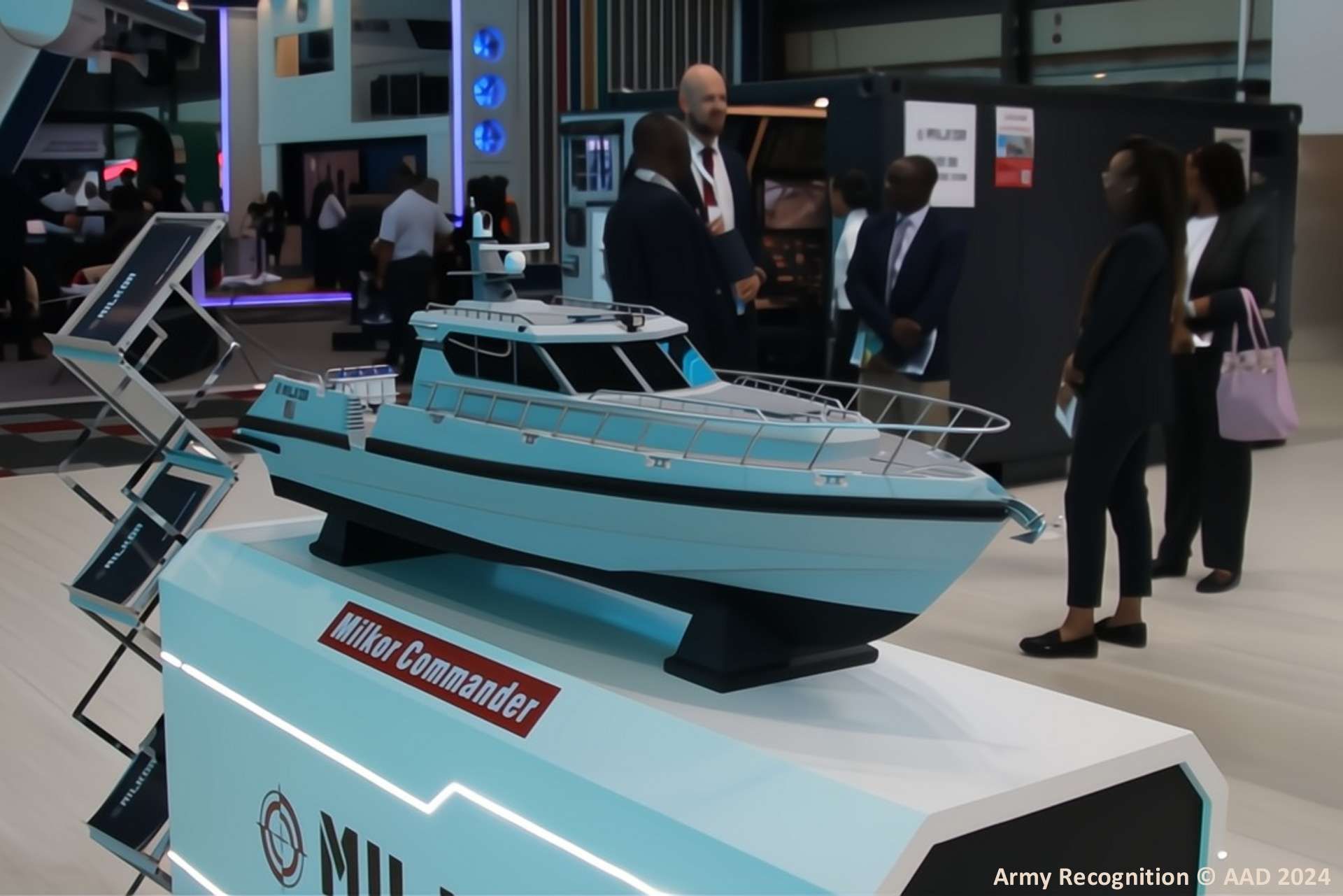
Milkor developed the Commander in response to the growing demand for high-speed naval response capabilities in the face of increasing threats such as piracy, human trafficking, and smuggling along the coasts of Africa and the Middle East. (Picture source: Army Recognition)
In the maritime category, Milkor presented the Milkor Commander, a 16-meter patrol craft developed by Milkor UAE for the Middle Eastern region. It was unveiled at the World Defense Show (WDS) 2024 in Riyadh, and its construction features an aluminum monohull designed for durability, high speeds, and long-range operations. While primarily intended for manned missions, the vessel can also operate as an unmanned platform. Development began in late 2023, and the craft is expected to be fully manufactured by February 2025, with all tests, including sea trials, completed by late 2024.
The Commander is adaptable to various roles, such as maritime patrol, high-speed interception, infrastructure monitoring, surveillance, and search and rescue. It has a maximum speed of 45 knots, a cruising speed of 35 knots, and can cover a range of up to 500 nautical miles. The vessel accommodates up to 10 people, features waterjet propulsion, and offers ballistic protection with a B6-level cabin. It is equipped with propulsion options of two engines, either Volvo D13 or CAT C12.9, both capable of up to 1,000 hp.
Milkor developed the Commander in response to the growing demand for high-speed naval response capabilities in the face of increasing threats such as piracy, human trafficking, and smuggling along the coasts of Africa and the Middle East. The vessel is aimed at serving the needs of coast guards and law enforcement agencies, with features tailored for quick response and long-duration operations. The Commander’s adaptability and robust design make it a reliable option for coastal security and maritime enforcement missions.
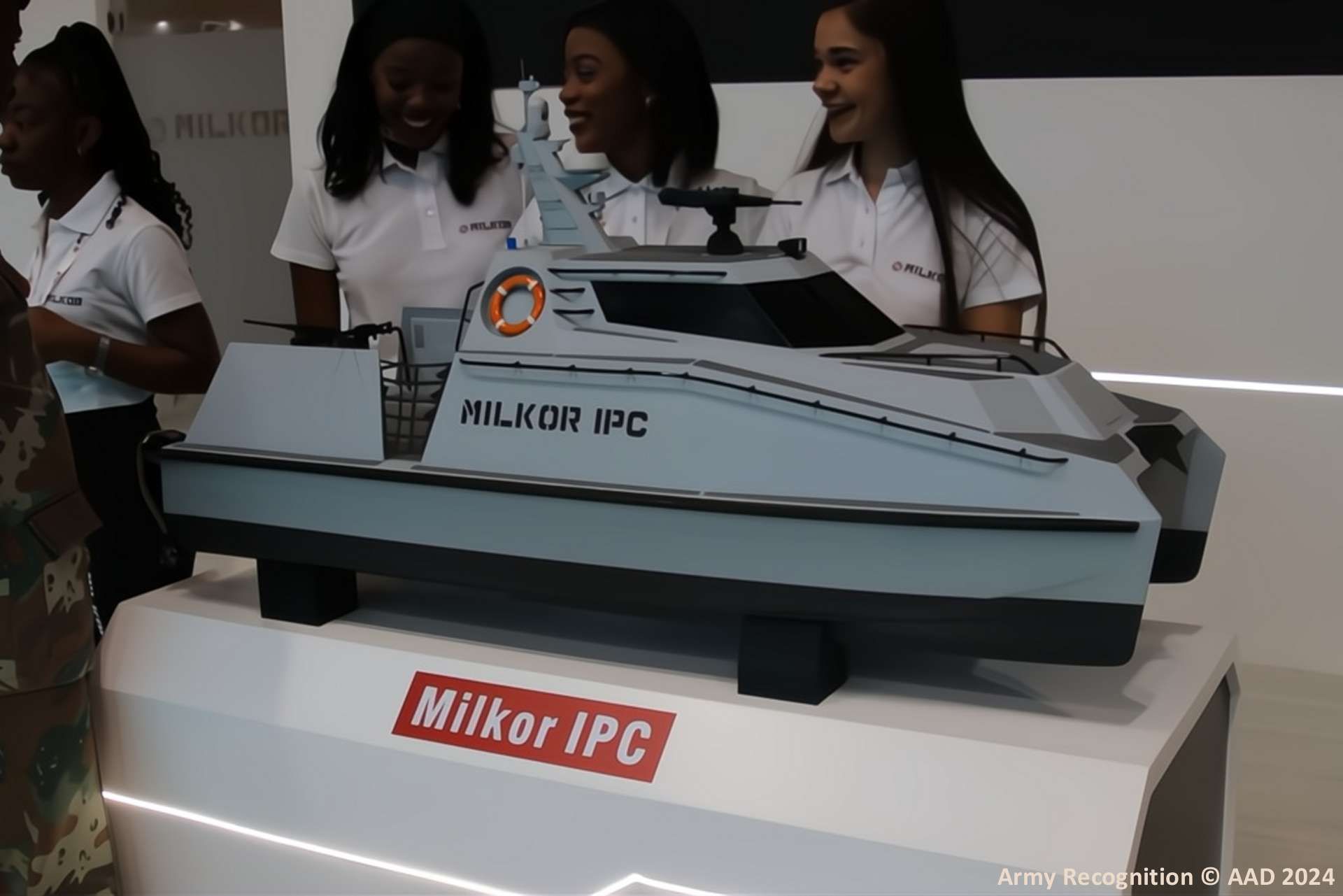
The Milkor Inshore Patrol Craft (IPC) can be armed with either a 40 mm automatic grenade launcher or a 12.7 mm remotely operated stabilized weapon system and can operate in both manned and unmanned configurations. (Picture source: Army Recognition)
On the other hand, the Milkor Inshore Patrol Craft (IPC) is a 12-meter catamaran designed for both manned and unmanned operations. It features a hydrofoil-assisted design to improve speed, fuel efficiency, and stability, reaching a top speed of 50 knots and a cruising speed between 25-47 knots, depending on sea conditions. Constructed with a fiber-reinforced composite structure, the IPC can accommodate various payloads, such as remote weapon stations, missile launchers, and surveillance equipment. The vessel has a maximum range of 650-750 nautical miles at 7 knots and an endurance of up to 5 days.
The IPC is equipped with facilities suited for long-endurance missions, including a full galley, shower, head, and three sleeping berths. Its command-and-control bridge includes pilot, navigation, weapon, and surveillance stations, supported by integrated communication, navigation, and surveillance systems. The IPC can be armed with either a 40 mm automatic grenade launcher or a 12.7 mm remotely operated stabilized weapon system, making it adaptable for navy, coast guard, or police operations.
The Milkor IPC can operate in both manned and unmanned configurations, with the unmanned version controlled via a tactical ground station using 4G, RF, or Satlink. This capability makes it applicable for various tasks such as harbor surveillance, coastal surveillance, sovereignty patrol, and route mapping, providing a versatile option for maritime security requirements.
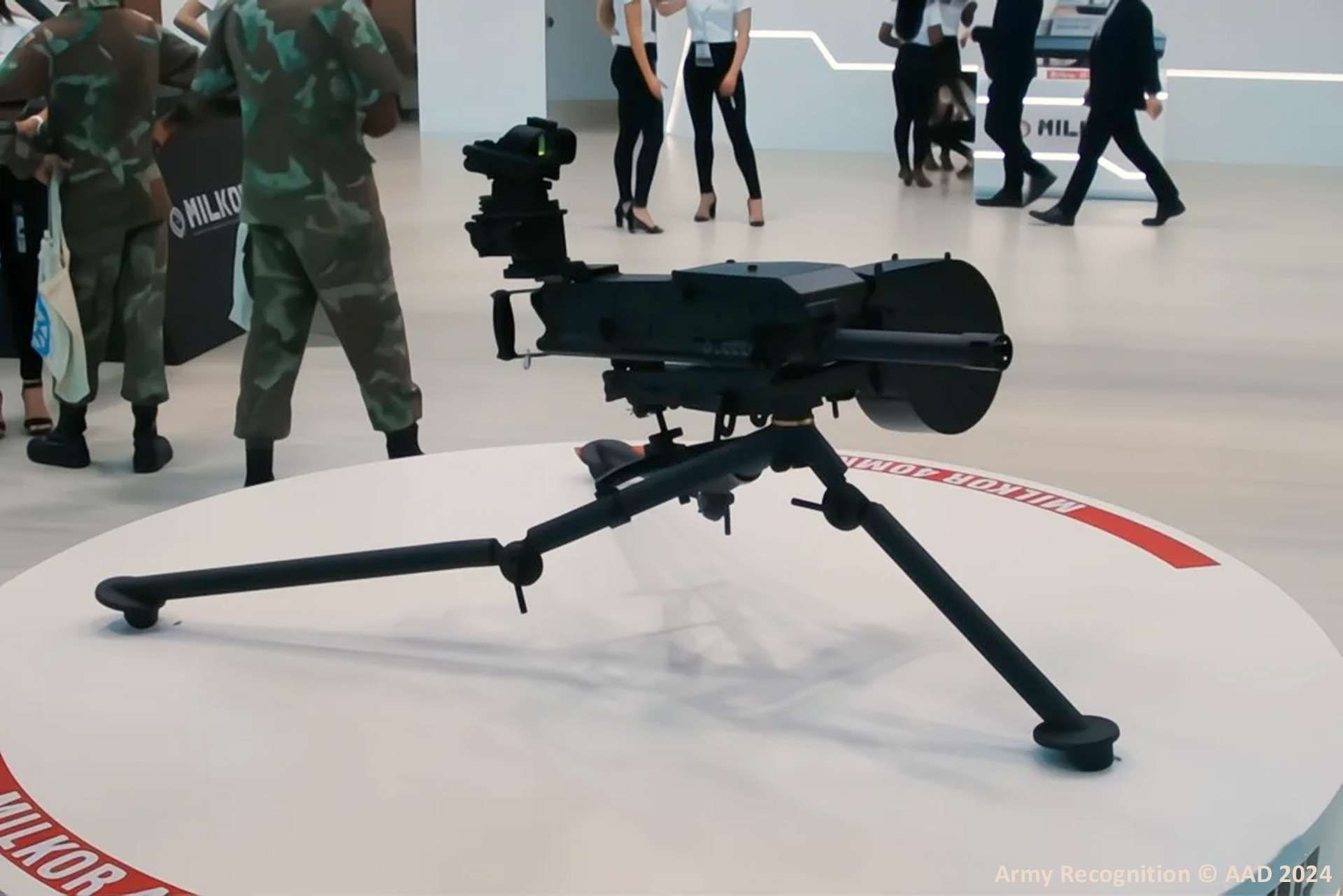
The Milkor AGL is adaptable for different mounting options, such as tripods, manned turrets, remote-controlled weapon stations (RCWS), or a recoil-mitigating cradle. (Picture source: Army Recognition)
Additionally, Milkor's weapon systems showcased at the event included the AGL, a belt-fed automatic grenade launcher designed for medium to long-range suppressive fire, utilizing 40 mm x 53 mm high-velocity ammunition. It has an effective range of up to 1,500 meters and a maximum range of 2,200 meters. The AGL offers a cyclic rate of fire between 380-480 rounds per minute and a sustained rate of 40-60 rpm. It weighs 27 kg, features an API Blowback action, an open breech firing position, and includes a safety selector with modes for safe, single shot, and automatic fire.
The AGL, developed since mid-2020 and presented at IDEX 2021, underwent testing to ensure it works with various ammunition types. Its belt-fed system is designed for prolonged firing operations and can handle longer ammunition belts. The AGL is adaptable for different mounting options, such as tripods, manned turrets, remote-controlled weapon stations (RCWS), or a recoil-mitigating cradle. It can be equipped with an advanced fire control system to enable airburst munitions capability and supports a STANAG 4694 NATO accessory rail for additional optics and targeting systems.
Milkor has focused on ensuring safety, operational efficiency, and compatibility in the AGL's development. The weapon is intended to be relatively light and manageable, aiming to maintain accuracy while managing recoil. The AGL is part of Milkor's broader range of grenade launchers, including the SuperSix multiple grenade launcher, UBGL (Under-Barrel Grenade Launcher), and the new MAR (Multiple Anti-Riot) grenade launcher.


























